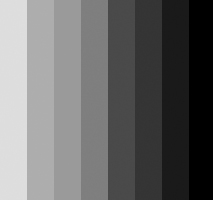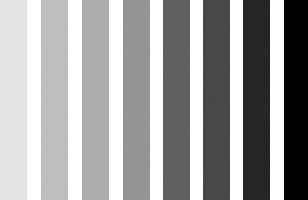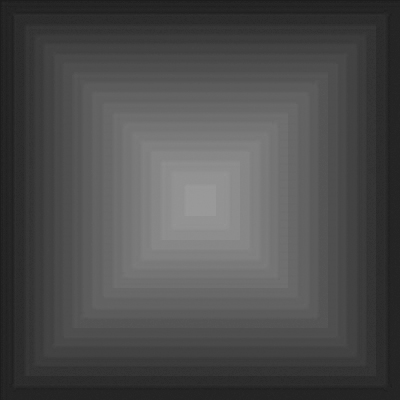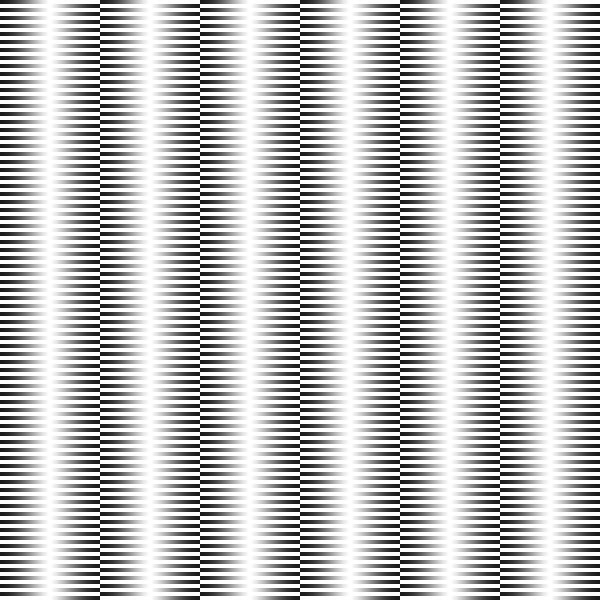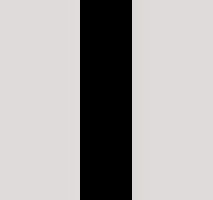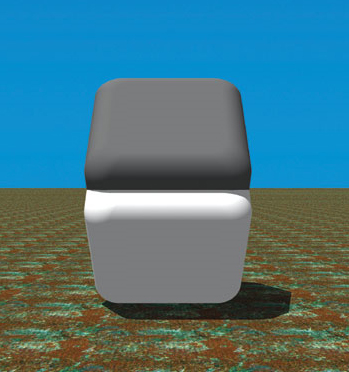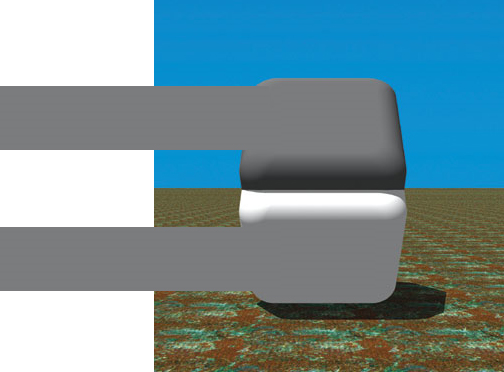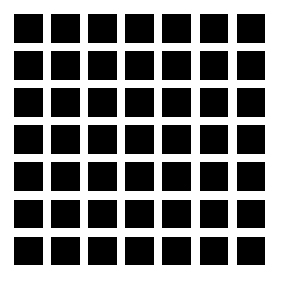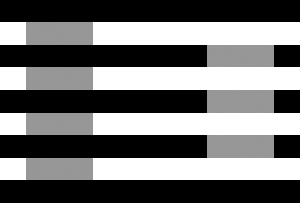Mach bands and other Optical Illusions
When viewing plain film images we tend to assume that what we see is a real and undistorted anatomical reality. This page starts with an illusion known as Mach bands and continues with other optical illusions which question whether we really see what we think we see. These are not all just quaint and quirky optical tricks (well ...some are). It is widely considered that Mach Bands, for example, can produce an effect that mimics Rigler's sign (pneumoperitoneum) on abdominal plain film.
Mach Bands
"Mach bands are an <a class="external" href="http://en.wikipedia.org/wiki/Optical_illusion" rel="nofollow" target="_blank" title="Optical illusion">optical illusion</a> consisting of an image of two wide bands, one light and one dark, separated by a narrow strip with a light-to-dark gradient. The <a class="external" href="http://en.wikipedia.org/wiki/Human_eye" rel="nofollow" target="_blank" title="Human eye">human eye</a> perceives two narrow bands of different brightnesses either side of the gradient that are not present in the original image." (1)
If you look closely at this grey scale it appears that each band of grey is not a consistent density. The left side of each band appears slightly darker than the right. This is another example of the Mach band optical illusion.
These are the same grey blocks separated by a white strip. They now appear as solid shades of grey.
The brighter bands at 45 and 135 degrees are illusory
(5)
The following figure has a motion effect that some have described as "flowing electricity". Watch out. Some people feel dizzy. The illusion combines Mach Bands and stripes
(5)
The Cornsweet Illusion
The two grey blocks appear to be different shades of grey- the left block appears lighter than the right block. This is an example of the Cornsweet illusion. The only difference between the two blocks is a slight graduation of the shade just on either side of the centre line
These are the same two blocks of grey with a black line superimposed over the centre. Now the two blocks of grey appear to be the same shade of grey
Source <a class="external" href="http://www.americanscientist.org/include/popup_fullImage.aspx?key=a/9TzeCnMGhUDKw5aZ77Tg4fFGhe5fVL" rel="nofollow" target="_blank">http://www.americanscientist.org/include/popup_fullImage.aspx?key=a/9TzeCnMGhUDKw5aZ77Tg4fFGhe5fVL</a>
This is a more extreme example of the Cornsweet effect. The top and bottom greys are the same shade of grey. I didn't believe they were the same shade of grey when I first saw this image. To prove the point, I extended the grey areas as shown below.
adapted from <a class="external" href="http://www.americanscientist.org/include/popup_fullImage.aspx?key=a/9TzeCnMGhUDKw5aZ77Tg4fFGhe5fVL" rel="nofollow" target="_blank">http://www.americanscientist.org/include/popup_fullImage.aspx?key=a/9TzeCnMGhUDKw5aZ77Tg4fFGhe5fVL</a>
Hold your hand over the image on your computer screen so that you can only see the grey bands on the left on their own. They are clearly the same shade of grey!
The Hermann Grid
"Why are there iridescent gray spots located at the intersections between black squares? and why do those spots disappear when you look directly at them?" (2)
Whites Illusion
Source: http://www.nku.edu/~issues/illusions/WhiteIllusion.htm
The grey rectangles on the left appear to be darker than those on the right (3)
adapted from : http://www.nku.edu/~issues/illusions/WhiteIllusion.htm
with the black lines removed it is easier to see that they grey rectangles are the same shade of grey (3)
Dynamic Luminance Effects
"Look at the center of a figure and try moving closer and further from the figure semi-quickly. The effect is a change in the apparent brightness" (4)
Well Known Bearded Deity (read all of the instructions first)
link for picture <a class="external" href="http://faithbaptistcynthiana.org/images/jesus_illusion_01.gif" rel="nofollow" target="_blank">here</a>
This one is just weird and has absolutely nothing to do with radiography (if you find a connection please let me know).
Instructions:
1. Stare at the four dots in the middle of the image for at least 30 seconds (a minute would be better)
2. Click here, stare at the white screen and blink a few times
3. Who do you see?
Anomalous Motion Illusion
I left the best to last- keep a vomit bowl handy if you intend to stare at this for a protracted period!
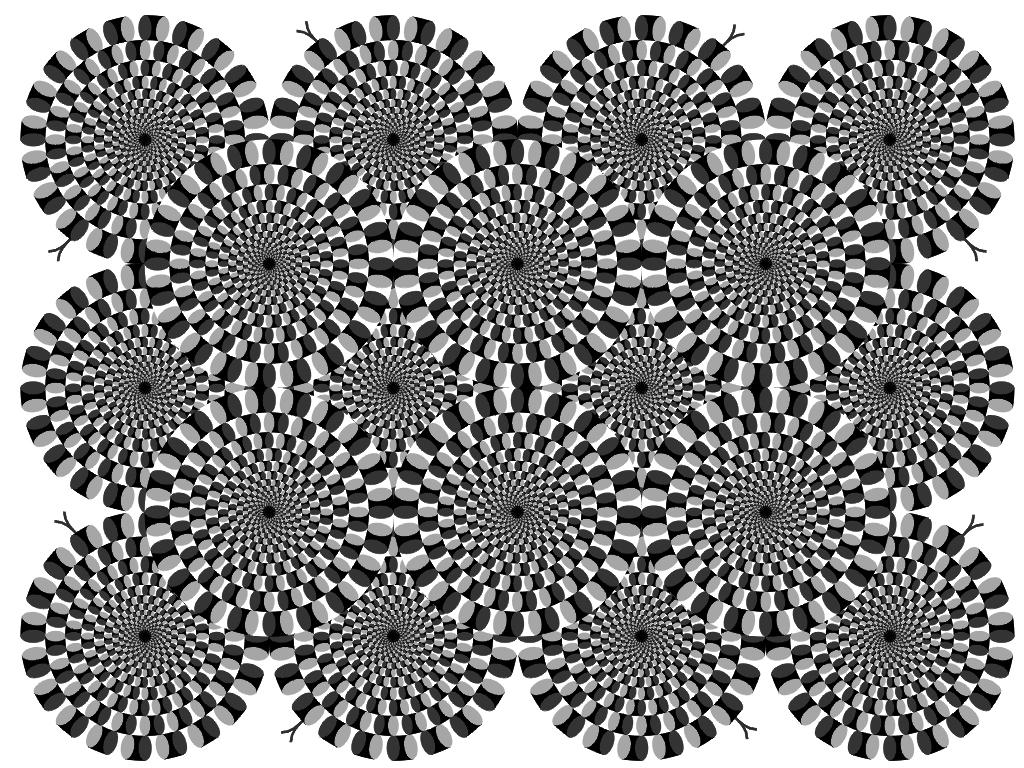
adapted from <a class="external" href="http://www.ritsumei.ac.jp/%7Eakitaoka/index-e.html" rel="nofollow" target="_blank">http://www.ritsumei.ac.jp/~akitaoka/index-e.html</a>
So What?
These optical illusions are largely just a bit of fun. The Mach bands are relevant to plain film radiography because of the potential to produce the illusion of an enhanced/accentuated interface between two structures.
References
1. Mach bands. <a class="external" href="http://en.wikipedia.org/wiki/Mach_band" rel="nofollow" target="_blank">http://en.wikipedia.org/wiki/Mach_band</a>
2 <a class="external" href="http://www.nku.edu/%7Eissues/illusions/HermannGrid.htm" rel="nofollow" target="_blank">http://www.nku.edu/~issues/illusions/HermannGrid.htm</a>
3. <a class="external" href="http://www.nku.edu/%7Eissues/illusions/WhiteIllusion.htm" rel="nofollow" target="_blank">http://www.nku.edu/~issues/illusions/WhiteIllusion.htm</a>
4. <a class="external" href="http://perceptualstuff.org/machbandsbasic.html" rel="nofollow" target="_blank">http://perceptualstuff.org/machbandsbasic.html</a>
5. <a class="external" href="http://perceptualstuff.org/machbandext.html" rel="nofollow" target="_blank">http://perceptualstuff.org/machbandext.html</a>

